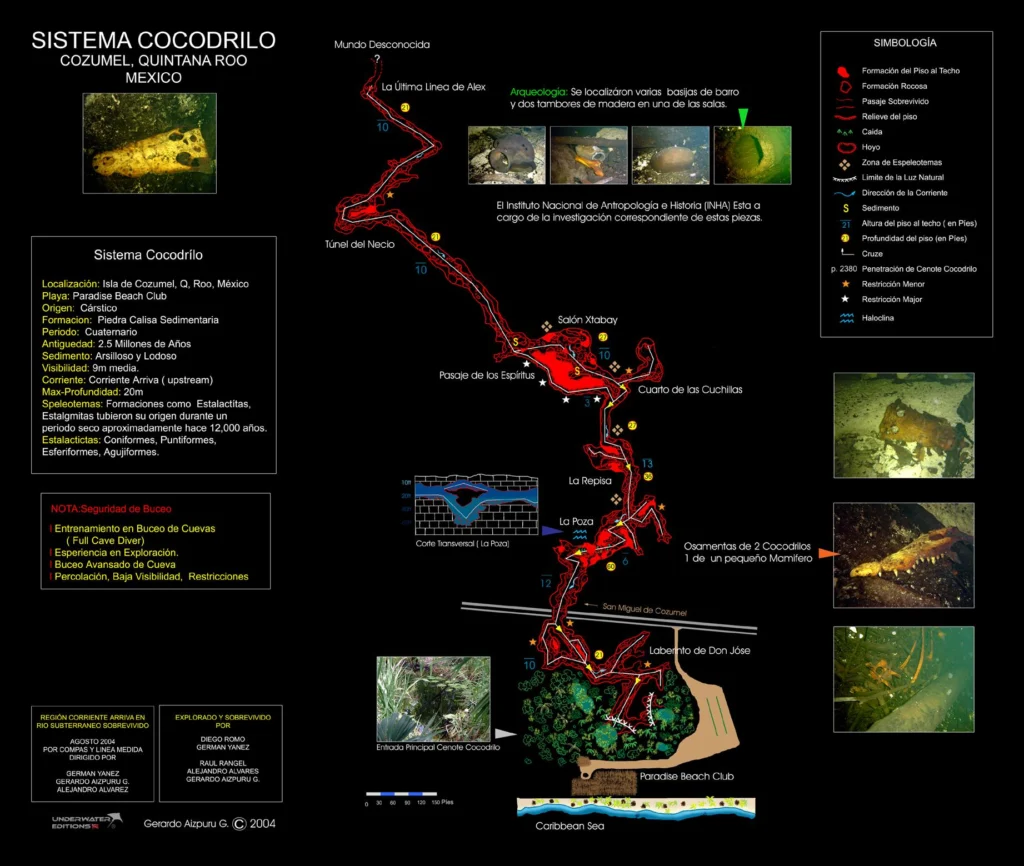Tragedy in Sistema Cocodrilo: The Final Dive of Brendan Lee Napier
| Incident Location | Diver Full Name (Deceased) |
|---|---|
| Mexico, Cozumel Island, Quintana Roo, Sistema Cocodrilo | Brendan Lee Napier |
On October 16, 2011, the air was calm above Cozumel Island, but below the surface a different story was about to unfold.
Brendan Lee Napier and four of his close dive buddies prepared their diving gear at the entrance to Sistema Cocodrilo, a sprawling cave system feared even by experienced cave divers.
The mission was clear:
- Travel 4,200 feet into the cave
- Reach a chamber known as the Air Dome
- Create a video map of the site
Everyone double-checked their diving tanks, rebreathers, diving computers, and lights. Brendan looked calm in his diving suit and mask. He volunteered to lead.
At 11:19 a.m., the team descended.
The Lead Into Darkness
The cave swallowed the divers. Their lights cut through the black water, reflecting against limestone walls. At first, the pace was steady, the team moving in tight formation.
But within 15 minutes, something changed.
Brendan’s swimming speed increased. His fins stirred up clouds of silt, making visibility difficult for the others. The group became stretched thin, each diver pushing harder to keep up.
One of his buddies later recalled:
“It felt like he was racing into the dark, faster than any of us expected. We couldn’t understand why.”
The First Signs of Trouble
Deeper inside, the cave grew narrower. The glow of Brendan’s light was fading into the distance. His breathing sounded fast through the comm units, sharp bursts against the silence of the cave.
Then, without warning, Brendan’s body jerked violently.
He began to convulse, twisting in the water. His diving mask tilted as he floated upward until he hit the ceiling of the cave.
By the time his buddies reached him, his regulator was already out of his mouth. Tiny bubbles escaped, drifting toward the ceiling.
A Shocking Discovery
The rescuers tried to stabilize him, but they noticed something alarming:
| Observation | Detail |
|---|---|
| Main regulator | Out of his mouth |
| Bailout regulator | Deployed, dangling uselessly |
| Rebreather loop | Closed |
| Bailout tank | Closed |
His life-support systems were shut off at the worst possible moment. Brendan was unconscious, drifting in the flooded cave while his team struggled to react.
A Desperate Struggle Underwater
When Brendan’s body went limp, his dive buddies reacted with urgency. His jaws were locked tight, clenched as if in pain. Two of them worked together, forcing his mouth open. They managed to wedge in a regulator and purged it, blasting air inside to keep him alive.
The team began the long swim back, one diver holding Brendan steady while another kept pressing the purge button. In the black silence of the cave, every second felt heavier.
The Long Swim Out
It took eighteen minutes to reach the surface.
That stretch of time must have felt endless. They kicked as fast as they could, dragging Brendan’s lifeless body through the twisting cave passages. Their diving computers counted down precious minutes as their tanks drained.
One diver later recalled:
“We were fighting panic. All we could think was: keep him breathing, keep moving, don’t stop.”
Breaking the Surface
When they finally broke into open water, sunlight glared above. The team tore at Brendan’s diving suit and gear, cutting straps to free his chest for CPR. His diving mask was ripped away, regulators tossed aside.
On the rocky shoreline, compressions began. Every breath forced into his lungs was a battle against time.
Help Arrives Too Late
An ambulance reached the site twenty minutes later. Paramedics rushed in, taking over the CPR. Tubes, oxygen, desperate commands filled the air.
But Brendan did not respond.
Despite everything—purging air into his mouth underwater, the frantic swim out, the CPR on land—he could not be revived.
No Mistakes Made
When the dive team replayed every moment, they found no error in Brendan’s actions. He had followed the plan. He had not broken a single rule. His diving gear had been checked, his diving computer worked as it should, and his tanks were filled from the same source the team trusted many times before.
For his buddies, the mystery was unbearable. Why did Brendan collapse so suddenly, while the others surfaced alive?
The Autopsy Results
The answer came only after the medical exam. The autopsy revealed something chilling: carbon monoxide poisoning.
This invisible killer had been inside his breathing gas. The tank that was supposed to keep him alive was silently poisoning him from the first breath of the dive.
The symptoms made sense in hindsight: his sudden acceleration, the convulsions, the loss of consciousness. No amount of skill, no perfect dive plan, could have stopped what was already in his blood.
Lessons Carved in Tragedy
The team came together, shaken but determined. They made one vow: from now on, every diver would carry a carbon monoxide analyzer in their kit. They would check every tank before a dive, no matter the source.
They now urge all divers to do the same, to never assume a fill is safe. As one teammate said:
“We trusted the gas. That was our mistake. Never again.”
This tragedy turned into a warning for the diving world—a reminder that danger can hide not in the cave itself, but in the very air inside the diving mask and suit.

